
Those aren’t the limits of storytelling approaches, of course. We do well to study — or at least tune into — the rhythms of music, the structures of movies, the imagery of poetry, and more. Overt examples are always nice.

Ted Ringger
I was reminded of that early this year when I opened a friend’s blog post. Ted Ringger is a retired environmental scientist and one of those friends who have turned a lifelong passion for photography from a hobby into a studied art. He keeps a blog of his work as much for his own archive and learning as for any public following. (He recently told me he has four subscribers and averages between zero and 20 views per post, depending on subject. “We’re talking small potatoes here,” he said. “But this was never envisioned as a site that draws readers and advertisers…just an outlet for my interests.”) He has made a mission of photographing the graves of American presidents, baseball stadiums, and all 50 state Capitol buildings — inside and out. He has an especially keen eye for light, shapes and textures in architecture and nature, but don’t ask him to shoot a friends-or-family gathering; by his own admission, photographing people is not his forte.
In sum, Ringger is not a professional photographer or journalist of any stripe. He doesn’t work to build an audience. And he isn’t comfortable focusing on people. So what can we, professional storytellers who obsess about audience and people, learn from him? Lots. Especially if you pay attention to what he says about specific techniques, and then connect the dots from to your own story work.
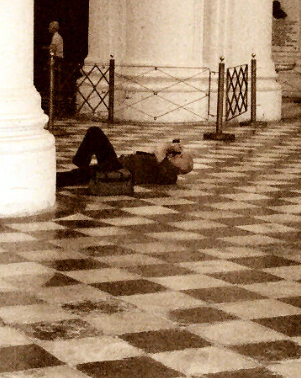
Ted Ringger "looking up" while photographing the ceiling of Granada Cathedral, Spain, October 2005
That’s what jumped out at me when I read one of his blog posts in late January. It was called “Look Down,” the third in a loose series called “Where to Look.” (I say “loose” beyond loosely; Ringger’s first post in this trilogy dates back to 2011.) This one probably caught my attention more than most because it was a bit unexpected. I’m accustomed to his posts of images from nature and especially those of ceilings — “Look Up” — but don’t usually expect such intimate, grounded images.
It also caught my attention because his post was such a clear articulation of a valuable lesson for all storytellers. Ringger chronicled, in images and text, what he saw when he varied his viewpoint. Rather than always and only seeing the world at eye level — a common perspective — he has trained himself to slow down and consider the stories that the world offers up when he considers it from fresh angles, with fresh eyes.
I asked Ringger’s permission to share his blog and photos. I didn’t tell him it would instantly multiply his audience by a factor of several hundred, lest I scare him off. Below is a lightly edited version of his “Where to Look” trilogy. It starts with the most recent,”Look Down,” then includes earlier posts (“Look Up” and “Turn Around”) in reverse chronological order. I have inserted a few annotations about how his visual lessons apply to any reporting, and especially to writing.
To read the blogs without the annotations, click on the Hide Annotations link, which can be found on the righthand menu of your website or the top menu of your mobile screen.
Look Down
From “Images and More” by Ted Ringger
Jan. 28, 2019
By now, you might understand that unless I’m forced to take pictures of people, I prefer to document places and things. While most stories put a central focus on people, places and things can also serve as the center of our stories. Places are the stages that bring a story to life, or even can be profiles in their own right. Things, seen acutely, give us the revelatory details that provide icons of meaning and metaphor, or even structural devices to carry readers through a story. Over the years, I have suggested that we can find interesting images if we occasionally look in all directions. In 2011, a favorite shot was used as an example of what we can find if we turn around once in a while. The fast pace of journalism compels us to look in the moment and ever-forward. But stories come from somewhere. Learning to turn around, and see what led up to the moment we are writing about, gives our work essential context.
In 2017, using the ceilings of some of the grand cathedrals of Europe, the tip was about what you might see by looking up. My fanciful collection of state house rotundas is another good example, but forest canopies and cloud formations are as well.
This time, the ‘Where to Look’ series becomes a trilogy. I suggest that there are many image opportunities at your feet. Think of a fresh blanket of colorful autumn leaves or mosaics and artfully arranged cobblestones on an ancient street. As someone who has covered multiple refugee situations, and follows the U.S.-Mexico border tragedy closely, this made me think of what we’d see if we looked down, at the feet of all those who are walking toward some vague idea of hope.
When Hurricane Katrina flooded New Orleans in 2005, many of the city’s big trees were lost. Most street trees do not tolerate being under water for long. The magnificent live oaks can stand brief inundations; it is a Southern species after all. Thousands of trees were lost in the storm, including live oaks. The uptown street where the picture below was taken had many mature magnolia trees. Hardly any survived the flood. This is all that remained of one…3 1/2 years later…a gray, lifeless stump.
I
remember hearing about a post-Katrina piece in which a creative reporter noticed that the Yellow Pages (back when there was such a thing) had grown far thinner. He used it as a way to report who had lost and who had gained in the economic aftermath of the hurricane. In other words, he looked down at what was in front of him and focused in tightly.
Pine Street, New Orleans, after Katrina (Feb. 7, 2009)
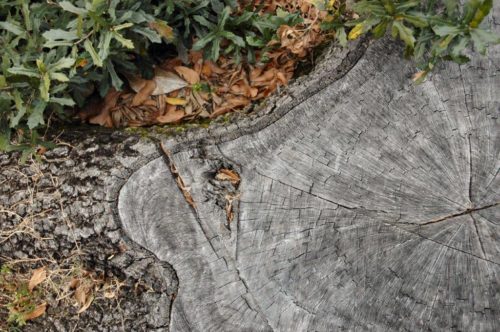
You can find wonderful pavement in Europe. Why make a sidewalk out of concrete when you can set smooth stones between colorful tile squares and allow tiny green plants to fill the spaces? Composition here offers a few considerations. I prefer NOT centering the cross of stones and plants although that can work. I could have cloned out the cracks in the tiles but I think they add character to the image.
The best of profile writers talk about developing “character.” Often that is revealed in what I’ve heard Lane DeGregory, of the Tampa Bay Times, refer to as the “bruise on the apple.” In other words, don’t ignore the small cracks in reality, because they often are the very things that give something, or someone, interest and credibility.
Marbella, Spain (Oct. 3, 2005)
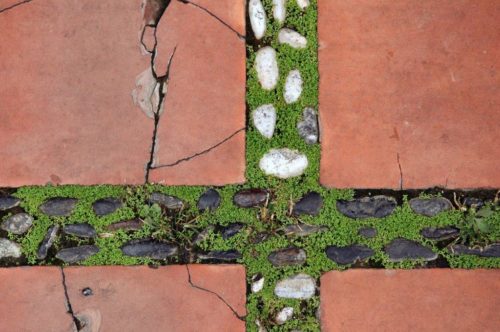
Of course we like the views from high-rise buildings. It’s great to be able to see great distances from a safe, high perch. I also like to look straight down. While most great narratives are told from close to the ground, sometimes we need to rise above to see how the immediate story fits into a larger frame. Our friends’ apartment overlooked a well-kept patio with plantings and a water feature. Crop out the furniture and people and I like it more.

High Rise Patio, Seattle (July 31, 2010)
The Oude Kirk (“Old Church”) is Amsterdam’s oldest building, consecrated in 1306. It happens to be in the city’s famous red-light district where, a short distance away, prostitutes advertise themselves from the brothel windows. In 1993, an anonymous artist inserted this bronze relief into the cobblestones of the church square. It pays to watch where you’re walking.
The best narrative writers spend as much time observing as they do interviewing. In order to take readers into a world they have never visited, you have to be able to describe it. In order to ask the right questions of story subjects, you have to notice the world they inhabit.
Oude Kirk (Old Church), Amsterdam (July 25, 2007)
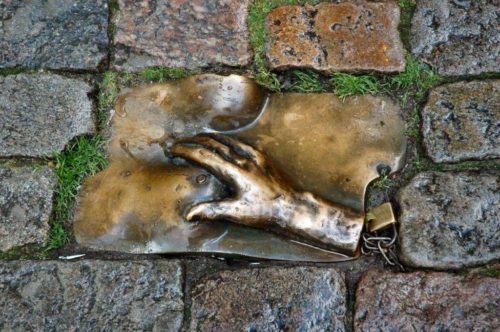
Never mind seeing the forest for the trees.
When we build the “nut sections” of our stories, we need to see the whole forest. But then we need to venture back into the specifics — the weeds, if you will — and take readers on the trail with us, letting them see, smell, hear, touch. Staying at one, static distance from our subject makes for boring work.
A walk in the woods can present many PO’s (‘photographic opportunities’) if you scale down your perspective. Think of flowers, leaves, insects, moss and lichen formations on old, weathered rocks. On a walk through a northern Wisconsin county park, we came upon this scene. The emerging mushrooms were on this ledge, slowly heaving the sandy soil out of their way to the surface world. I think the pine needles add texture and the fern a splash of color to the scene.
Ah, those little details that might be dismissed as decoration, unless we notice them and ask about them and realize they have meaning.
Mighty Mushrooms, Wisconsin (Sept. 30, 2010)
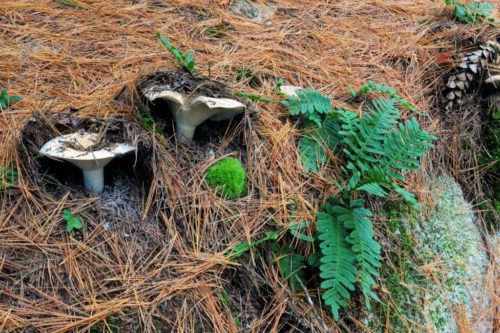
In conclusion, you have a camera…or a phone (ugh!) that can take pictures. You’re some place interesting where, if you look more carefully, there are images to be had. Look up. Look behind you. Look down. You can do better than take more selfies. The reporter is the viewfinder, but seldom the story. The storyteller, in whatever format, is the lens through which the reader, listener, viewer absorbs a story. And the angle, distance and focus of that viewfinder needs to be varied and creative.
Look Up
From “Images and More” by Ted Ringger
April 3, 2017
In the first year of this blog, my first ‘Tip of the Day’ was about looking behind you when you are out walking in great natural places…anywhere really. That different perspective — another angle of light, the other side of something — just might present the shot you didn’t know you were looking for.
As I’ve said before, I like great interior spaces. The architecture, materials and designs of historic (and modern) structures are full of photographic opportunities. They also are quite cooperative. They stay put and allow you to take all the time you need to get the perfect shot. Patience is among a photographer’s great traits. Writers, too, need to develop the patience to sit, look, wait for the moment to reveal itself, or a story subject to find the right words — and to see patterns that emerge and might actually reveal greater meaning. When I visit state capitols, if there is a rotunda, it just begs to be shot from directly underneath. The image may be two-dimensional but it is often balanced and colorful.
Few structures match cathedrals for architectural splendor. We Americans have an immature sense of time and history. I was born in what was one of the colonies and we would say things like, “That house there is the oldest building in the county…dates to way before the Revolution. Early 1700’s.” Please. We don’t know what’s old. This is another reminder to consider where the story of the moment came from. What is the history and evolution of events that led to what you are writing about in the here and now? Also, how is it like — or not like — a similar thing happening elsewhere? How do geography and culture affect current events?
I remember having dinner in a restaurant in Vienna where they have been serving food at that location since 1554. In York, England, I recall seeing a viewing area that highlighted the town’s settlement history. Across from us, the land was carved away to reveal the successive occupants and cultures that existed in the area. Like tree rings or exposed geological layers, 2,000 years of habitation were displayed, back to the Middle Ages and the Vikings before that and the Romans before that. Journalism is often called “the first draft of history.” But history itself can make for great stories if it is tied to present-day events. Or at least it can help us understand those events in a larger context. It occurs to me that those tree rings are, perhaps, nature’s version of the visual timelines we build into some of our stories.
I love visiting the ancient communities in European cities and especially photographing the inside of churches. The arches, altars and stained glass all present an opportunity to play with lines and geometric forms. This is where I always look up. This is far from the spiritual spirit of this moment, but looking up as a reporter often lets you think about who has power, and how that power plays out in events on the ground. You can’t help but follow the lines that start on the floor. This speaks to the connection between those in power and those affected by that power. They aren’t separate. Tracking that connection leads to some of our most important journalism. Seeing the powerful from the point-of-view of the powerless is how we give the powerless a voice. The windows and arches all direct your gaze heavenward. Look at the altar and it often rises up with candles and artwork, taking your eyes toward the ceiling.
Standing (or lying) on the floor, you see how far away the ceiling is. The view is flat and two-dimensional so what you are left to appreciate are the lines. Notre Dame (below) in Paris is old. Completed in 1345, I imagine they were so pleased to have a functional roof so high above the ground that additional decoration was hardly necessary.
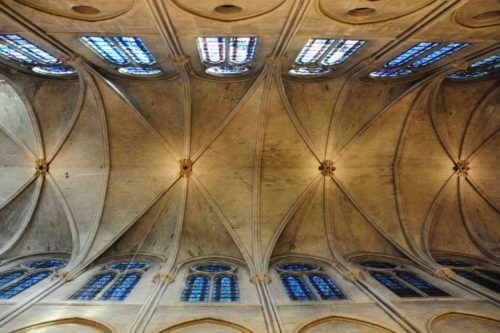
Ceiling of the Cathedral of Notre Dame, Paris (Dec. 26, 2009)
By the 17th and 18th century, Baroque Architecture was the vogue. It was the time of Counter-Reformation and the Catholic Church asserted its wealth and power in amazingly over-the-top ways. Melk Abbey in Austria is a great example. It’s as if every possible surface inside the chapel had to be gilded, sculpted or painted in some way.
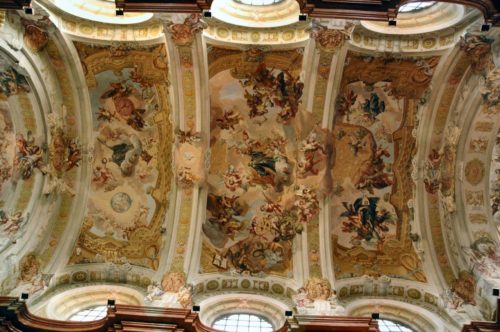
Melk Abbey, Austria (Aug. 8, 2007)
Across from the Royal Palace in Madrid, Spain is the Almudena Cathedral. Construction began in 1879 and was not completed until 1993. While the general appearance of the church reflects older, established architectural styles, the recent construction revises the terminology to “neoclassical” and neo-Gothic. The ceiling over the nave certainly shows some modern and colorful decorative touches.
When we use detail or adjectives in writing, we need to choose those that add meaning or understanding, and ditch those that are mere decoration. It all comes down to relevance.
Cathedral de la Almudena, Madrid (Oct. 10, 2005)
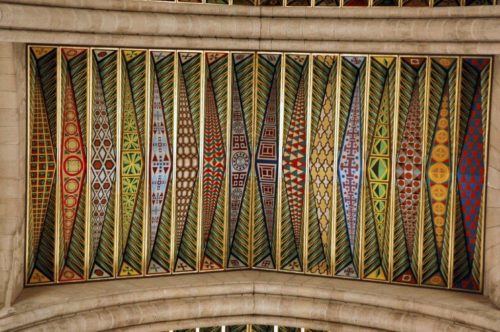
There you have it. Keep your eyes open. Look around. Sometimes the image you want is directly above your head.
Look Behind You
From “Images and More” by Ted Ringger
March 14, 2011
When it comes to picture-taking, there is nothing I like more than walking with the camera through beautiful country and grand spaces, looking for photo ops. Hiking through majestic forests, scenic shorelines, mountain trails, even the narrow streets and alleys of old cities, you can see terrific images. Sometimes, the footing requires your attention so you may not be looking at much more than what is in front of you. All I’m saying is that when you slow down long enough to consider framing and capturing a shot of what’s in front of you or to the side, turn around once in a while and check out the view behind. Always ask where a current situation came from. What is the then that led to the now? It will lead to understanding and sources you would otherwise miss. There just might be a shot worth your attention.
In May 2007, I was walking through the Mariposa Grove of giant sequoia trees in Yosemite National Park. It is REAL easy to be awed by what’s in front of you. Ginormous trees with great, red trunks stretching too high to see where they end. One can imagine that, with trees over 200 feet high, not much direct light reaches the forest floor. It was a wonderful place to wander and it was so easy to be drawn further down the trail to see what the next grand scene might look like.
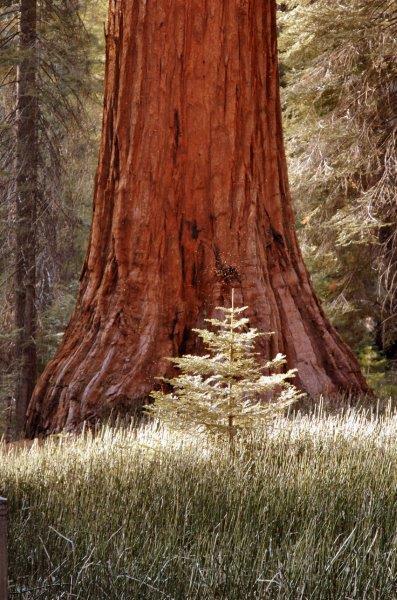
Mother and Son, Mariposa Grove, Yosemite National Park (May 2007)
I don’t do this enough but that day, I remembered to turn around. There was this fresh, green, youngster of a tree, with a sunbeam shining right on it, directly in front of a big, red mass of a tree. Consider generations as a fabulous frame for narratives. They reveal both connections through time, and how things have progressed — or not. They are a natural and engaging way to access history and culture, and almost always open the door to scenes, character and anecdote. Like Ansel Adams Always study the masters, in whatever craft you pursue. described when he made his iconic “Moonrise, Hernandez, New Mexico” image, I had enough time to snap off one shot before the sunbeam moved on. Don’t miss the chance to capture what’s right behind you. Current events move at a blinding speed. Sometimes the best journalism stops for a moment to teach a little relevant history.
